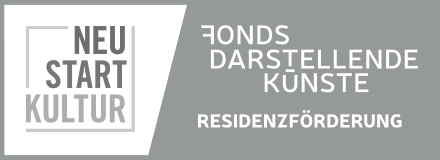
Introduction
Layers of Intimacy is a practical and artistic research into the worlds of composition and sensuality. How do we make decisions when being intimate and/or composing sex with each other? What are the skills, nuanced sensibilities and compositional intelligences at work, and how do we train them? We are building upon an existing improvisation method, Present Time Composition (PTC) by Dr. Alan Bern, and using other forms and platforms of embodied practice, research and explorations; interviews, questions of reverse engineering, literature and film research, participatory observation at play parties, etc. This is week #3 of our time together at the Sensemble Theater in Augsburg, within our flausen+ residency!
Making PTC_sex
PTC is an improvisation method and learning framework for collectively improvised, highly differentiated performance works, drawing upon and honing our ability to quickly make coordinated, nuanced decisions. Our ensemble trainings of PTC in the context of (kin-)aesthetic choices during sex have been an embodied practice beginning with identification of ‘impulses’. ‘Impulse’ is defined as any information-stimulus urging a cognitive system to make a decision and/or change the current state. Impulses are understood as any kind of shift, ‘anything that happens’, in the perception of the improviser.


How to Isolate Impulses? Week #3
To warm up our attunement to impulses, we would begin a day with short labs of the 1ABC exercises (see Log Book #1). Then, our continuous duos (time spent in improvisational relation to each other’s bodies) this week had limited ‘procedures’ or scores in order to become aware of the impulses (and their characterizations, i.e. continuous or reactive) that arose within the specific context of those different foci. For example, we took on ‘active’ or ‘passive’ roles in relationship to one another in varying levels of intensity, highlighted the use of objects or sound as a compositional quality, introduced lacunas (gaps and general pauses), found and developed ‘motifs’, or explored ‘vectors’ of rising and lowering thresholds for specific qualities, including sensuality itself. This was the analog of how our mentor Dr. Alan Bern explains that “composers intentionally limit the parameters of a new work when starting” in order to find depth and freedom within formal restrictions, as well as become more aware of the manifold nuanced variations possible within such confinements. In order to explore the formal compositional relationships between juxtaposed improvisations, we also established and practiced ‘calibration’ exercises to ensure our attunement to collective thresholds.
>>>>>
WEEK 3 – Exercises, activities and try-outs.
A somewhat “complete” list of our research activities
“It is all significant, nuanced communication – how do we improve it?”
“We are not here to create the most beautiful improvisations, but deep immersions into moments for practice”
“Once the ‘formal compositional’ point of view becomes more embodied, it lets you totally BE inside of each moment that goes into realizing that form”
ACTIVE / PASSIVE – compositional baseline roles
Attention economy (“the audience gets to judge”) vs. Pleasure Performance
(“shared experiences of pleasure on the in- and outside”)
We engaged with training the wide range of fundamental compositional roles within sex and sensuality. We want to be able to dive into delegating roles within a given compositional creation so that we can explore relations and material coming out of this formal restriction or distribution. We took it from where the last “Layers of Intimacy” research group left it: using the proposition of “active passive” as a modification of the PTC_music roles “background / foreground”. “Active passive” does not only refer to the penetrative or power-related roles of “top / bottom” (or, more accentuated, “dom / sub”), but also to the dimensions of “giving / taking”, “facilitating / receiving”, “leading / following”, “making happening / letting happening” and many more shades of these fundamental compositional roles.
This work-chapter is based on the PTC_music work on “foreground / background”. In music, this delegation is fully phenomenological: whatever catches the attention more, functions as a foreground (a typical example is a melody being the foreground, with a rhythmical base being the background – but we can also easily imagine the many ways of how the rhythmical base becomes more interesting and moves into the foreground without turning into a melody…).
This work is a relational work, whilst in PTC_music the measuring point for “foreground / background” is an external one from the outside – as whose attention will decide what is background and foreground? Someone on the outside – the audience / the spectator. In “the art of sex and intimacy”, the audience is replaced by “the witnesses”. The closest we get to what we know as century-old cultural practices (along with its institutions and conventions) of the theater – for the performing arts – are playspaces / play and sex parties / “love temples” and similar. Here, “the audience” consists of people who might stay on the outside and witness, but are at all times also possible participants, joining in carefully on what is happening in the various epicenters and peripheries of the play space. This culture of being an involved audience member shifts the focus away from power relations of consumption – the witness holds in their behavior a shared responsibility for the intimacy inside the circle. The witness doesn’t just “take” from the action of the sexual play in front of them, but is also called to contribute – through ways of holding space, and, at times, joining or otherwise facilitating. For people who have been looked at while having sex or being intimate, we might recognise the experience of feeling “being taken away from something”. We can recognise the difference between someone watching with involvement, with vulnerability and receptiveness, of witnessing in respons-able ways, and someone observing with a more voyeuristic or, even, with an entitled attitude “on the outside”, thus also not responsible while potentially “judging without risking…What’s your flesh in the game as a witness of intimacy?”.
(Side note: even if we enjoy and get a ‘kinky thrill’ from the quality of “being observed” and also “being judged” as part of our intimate play, this takes on the quality of a roleplay, in which the “audience” also has a role to play – somewhat negotiated, somewhat consciously part of the play. I.e. a participating witness, rather than the conventionalized paying concert goer who can lean back in their chair and consume)
We need to develop the frames and conventions in which “the art of sex and intimacy” can be shared and witnessed. We need to consciously take “the audience” into that space and define bodily and spatial attunements in order to create a shared awareness that will benefit both “the seriousness and artistic beauty of the compositional work”, but also “the fragility of intimacy being made on spot between people on the inside, vis-à-vis people on the outside”. All this being said: we probably need some conscious consent moment together, when inviting people as non-active witnesses into our sensual improvisations, to build a container that works. And maybe, at another historical point, we will have sex theaters with incredibly intimate sexy performances happening and everyone will know qua convention how to behave and how to respectfully and fruitfully make this happen. From “attention economies” to “pleasure performances”?


Active Passive – how we worked on it in Continuous Duos
This week, we have been looking into the relation of what we here name as “Active passive”. This is in lack of better words. We find this compositional element being essential for sex, and yet hard to define in language. Other dichotomies we elaborated in this context included:
Taking & receiving
Top & dom
Leading & Following Convening & Allowingy Sparking & burning
Horse & carriage
Form & space
Foreground & Background
…
Our main form of the embodied research is now established in continuous duos: We are sitting in a circle and two people are entering into the middle and start playing. Those playing in the center can either drop out or be forced out from the play, with another person entering and continuing to play.
Some findings in composition of having Active/Passive roles:
We were further changing the composition by scaling the dynamics:
-> one person 90% active the other 10%, fade over into switching the roles, end at 10/90 (inversed roles)
-> we introduced working with less extreme role-division – 70/30, which were experienced as giving us more material for negotiation, more mutually composing. -> We tried out a different setup by having two parallel mats (see Logbook #2).
It was experienced as creating more “falling into it”, more playfulness, and more pleasurable encounters. Not being witnessed changed a lot.



CONTINUOUS DUOS w focus on ONE IDEA
CONTINUOUS DUOS w focus on OBJECTS
CONTINUOUS DUOS w focus on LACUNAE
CONTINUOUS DUOS // Motivic Development
CALIBRATION



CONTINUOUS DUOS/TRIO w focus on VECTOR of SENSUALITY
As part of our research, outside of the frame of PTC, we engaged in:
Mentor Dr. Alan Bern work session (Fr. 20th Sept)

Questions that linger:
> How do we apply traditionally composed frameworks (i.e. music) to a form/practice (sex) that is generally improvised – how do we compose interesting and pleasurable works of sex? What are the cultural references and frameworks, the “institutionalized practices” for such an “art of sex”? What are thus the politics, aesthetics and conventions we need to consciously navigate?
> “the elephant in the room” – the question about whether we are composing towards an audience/an art work in itself or towards the experience of pleasure and connection? Is there a big difference in the end? How so?
> What does it mean to have witnesses instead of an audience when we understand “sex as performance”?
> We were just touching the surface of verbal stories and fantasies, which creates a clear narrative. How does language influence our capacity to improvise and go to interesting places we have never been….
>Deepen the work on composing with objects
> create and try out interesting frameworks for witnessing and consent for our “makingoff” showcase on Oct 2nd 2023, Sensemble Theater Augsburg
>…

flausen+headquarters
Alexanderstraße 124
26121 Oldenburg
flausen+gGmbH
Klävemannstraße 16
26122 Oldenburg
Das überregionale Netzwerk flausen+ wird gefördert von der Beauftragten der Bundesregierung für Kultur und Medien über das Programm “Verbindungen fördern” des Bundesverbands Freie Darstellende Künste e.V.
Gefördert vom Fonds Darstellende Künste aus Mitteln der Beauftragten der Bundesregierung für Kultur und Medien im Rahmen von NEUSTART KULTUR.
Gefördert vom Fonds Darstellende Künste aus Mitteln der Beauftragten der Bundesregierung für Kultur und Medien.



